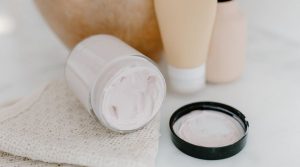Coconut oil has gained a great deal of popularity as a hydrating, nourishing base for skin care products, and is so gentle that it can be applied directly
Though there aren’t any scientific studies which specifically measure the success of treating diaper rash with coconut oil, the product’s natural emollience and anti-inflammatory properties suggest that it may be an effective natural alternative to other topical rash treatments.
Curious about what coconut oil can do for your baby’s skin conditions? Let’s dive in.
Is coconut oil baby-safe?
Unless your baby has a known coconut allergy, using coconut oil topically is generally safe. That said, as when introducing any new topical product, it’s best that you start with a patch test.
Apply a small amount of coconut oil to the inside of your baby’s forearm, and monitor the application site throughout the next few hours to observe any reactions. If your child experiences any swelling, itching, redness, rash, warmth, or other discomfort, do not proceed with using coconut oil to treat their diaper rash.
If no reaction is observed, you’re in the clear to go ahead.
But, wait:
These tips can help to assure that you’re buying the best possible coconut oil for treating your child’s rash and using it safely.
- Choose a reputable brand. Because coconut oil is so popular in the health and beauty world, numerous brands, known and unknown, have embraced the ingredient. Stick to natural brands you trust, which are more likely to be pure and free of additives.
- Unrefined vs. refined coconut oil. You’ve likely seen coconut oil at the grocery store, and it may even be a part of your regular cooking routine. However, the unrefined coconut oil often used in cooking isn’t ideal for skin care — you’ll want refined coconut oil (you can buy this in the very same aisle, just read your jars carefully).
- No added fragrances. If you’re buying refined coconut oil packaged as a beauty product rather than a cooking product, be sure to avoid any options that include fragrances. This can defeat the point of using the oil as a diaper rash treatment by introducing a new potential irritant.
- ONLY warm oil in your hands. Warm oil or lotion are both soothing, and it’s tempting to try to warm up solid coconut oil to give your baby a more comforting treatment. You should do this, but only in your hands — using the microwave or stove can make the oil way too hot for your baby’s sensitive skin.
Does coconut oil treat diaper rash?
We know that coconut oil has the potential to soothe inflamed, irritated, and itchy skin.1Intahphuak, S., Khonsung, P., & Panthong, A. (2010). Anti-inflammatory, analgesic, and antipyretic activities of virgin coconut oil. Pharmaceutical biology, 48(2), 151-157.
doi.org Additionally, it’s been scientifically linked with the promotion of wound healing.2Lin, T. K., Zhong, L., & Santiago, J. L. (2018). Anti-inflammatory and skin barrier repair effects of topical application of some plant oils. International journal of molecular sciences, 19(1), 70.
ncbi.nlm.nih.gov While there’s no direct research connecting the use of coconut oil with the successful treatment of diaper rash, what we know about the product suggests that it can be safely attempted as a natural diaper rash remedy. The oil’s thick consistency has the potential to create a barrier between skin and moisture, which can help the rash to heal and prevent it from worsening.3Vaughn, A. R., Clark, A. K., Sivamani, R. K., & Shi, V. Y. (2018). Natural oils for skin-barrier repair: ancient compounds now backed by modern science. American journal of clinical dermatology, 19(1), 103-117.
springer.com
Using coconut oil to treat diaper rash
Follow this step-by-step guide when treating your baby’s diaper rash with coconut oil.
- Wash your baby’s bottom and thoroughly pat dry; avoid rubbing, which can further irritate and inflame their delicate skin.
- Warm about a teaspoon of coconut oil between your hands; alternately, warm the jar in warm water, but never use a stove or microwave.
- Gently apply the coconut oil, very softly covering the rash without leaving a lingering layer of moisture. The coconut oil should leave a thin coating on baby’s skin, which should be allowed to absorb before their diaper is replaced.
- Once your baby is over six months old, you may choose to use skin-friendly essential oils like tea tree in combination with coconut oil, but be aware that the dilution ratio that’s safe for children is much higher. Coconut oil-based diaper creams are also an option.
Typically, a diaper rash will begin to resolve within a few days, and redness and irritation should decrease after a few oil treatments. However, this is not a catch-all cure by any means, and your mileage may vary — not all diaper rashes resolve with coconut oil treatments, so if they don’t seem to be effective for your baby, move on to another method for the sake of their comfort and health.
When do I need a pediatrician for diaper rash?
Generally, diaper rashes can be resolved through proper treatment and maintenance of good habits, even in babies who are predisposed to rashiness. However, if your child’s rashes are happening too often or aren’t improving with treatment, it’s time to consult the pediatrician.
These symptoms also indicate that your baby’s diaper rash needs medical intervention:
- Extreme pain
- Swelling
- Itching
- Sores, blisters, or boils
- Blood, pus, or discharge
- Fever
Tips for treating and preventing diaper rash
Though some babies are more predisposed to diaper rash than others, maintaining the following habits can help to treat and prevent future occurrences.
- Clean, dry diaper area. Bacteria and moisture are the primary culprits in triggering diaper rash, so making sure to change your child as soon as you know they’ve soiled and performing a gentle cleaning and drying of their bottom during each change can prevent the conditions which allow the rash to form. Additionally, don’t apply coconut oil or other rash treatments until your baby’s skin has been thoroughly dried, or they will not be as effective.
- Naked time. When you’re able, allowing your child to “roam free” without their diaper will keep rashy areas dry and allow them to heal (but, throw down some old towels or a ratty comforter first).
- Clean hands before AND after. Common sense says you should wash your hands after changing their diaper, but washing them beforehand as well helps to eliminate any pesky germs you might be bringing to the table.
- Check their diaper size. If it’s almost time for your little one to size up in diapers and their rashes are getting more frequent, a tight fit might be the culprit. Try a larger diaper and see if the extra room helps rashes to heal and rash frequency to decrease.
- Be sensitive skin-friendly. When it’s time for a bath, always use either plain water or a gentle, soap-free or mild soap cleanser, and take extra caution to be gentle when washing the diaper area, never rubbing or scrubbing to wash or dry (instead, gently pat). Skip baby powder — the AAP recommends against it– and any fragranced products, be they bath soaps, laundry soaps, fabric softeners, or dryer sheets.4Mofenson, H. C., Greensher, J., DiTomasso, A., & Okun, S. (1981). Baby powder—a hazard!. Pediatrics, 68(2), 265-266.
https://pediatrics.aappublications.org/content/68/2/265pediatrics.aappublications.org,/mfn> - Choose breathable, natural fabrics. When baby’s clothes and diaper covers (if you’re a cloth diaperer) are cool and breathable, it’s easier for their skin to stay dry, comfortable, and rash-free. Cotton, bamboo viscose, and hemp are among the top-recommended naturally breathable fabrics for babywear.
Our takeaways
Though uncomfortable, diaper rash is a common condition which generally resolves within a few days of treatment. Coconut oil has not been scientifically proven to treat diaper rash, but its known ability to assist in wound healing combined with its observed anti-inflammatory properties and anecdotal evidence about its benefits make it a relatively safe natural remedy to attempt.
Always patch test your baby or toddler when introducing a new product, and discontinue use if a reaction occurs. In order to treat the rash effectively and prevent further rashes, keep your baby’s skin dry and comfortable through frequent diaper changes with clean hands, diapers that fit properly, clothing that breathes, and bath and laundry products that avoid fragrance.





